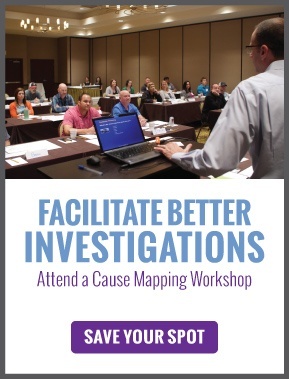Your RCA process is the roadmap to an effective and sustainable RCA program
Problem solving should be treated as a work process just like any other task that’s critical to your operations. When a problem happens, it’s important to have clearly defined steps for what is done, who does it, when is it done and how it should be done. Clearly defined roles and responsibilities are essential for any program to be successful. It’s no different for problem solving and your root cause analysis program.
Who's on first
Most organizations write a policy document, but as with any other task, the work process is a key component for providing clarity and continuity to a program. When an incident occurs who is responsible for starting the investigation? Based on the type of incident and magnitude, what are the requirements? Who is responsible for collecting, organizing and documenting all the information? Does the investigation consist of one-on-one conversations, or do we have a meeting everyone attends? How are specific lessons shared across the site or company? How do we communicate problems between frontline and management?
Engagement from everyone
All these questions require a plan. Programs don’t organize on their own - people make things happen. At ThinkReliability, we’ve seen quite a few RCA programs. We know how to make them clearer and more effective. We know how to get involvement from the frontline and management. Problem solving should be treated as a core capability and a normal part of everyone’s job. The effectiveness and sustainability of your root cause analysis program are dictated by a clearly defined root cause analysis process and the commitment to executing the process from management to frontline.
Five Elements
It's important that key stakeholders are deeply involved in evaluating and developing a customized RCA program that will drive results and integrate within the current processes of the organization. An effective and sustainable root cause analysis program is based on five key elements:

- Demonstrated Method
- Defined Process
- Application-Based Training
- RCA Champions
- Expert Support (RCA Help Desk)
Evaluate your RCA Program
ThinkReliability’s root cause analysis program review has three phases designed to leverage the strengths of the organization’s current program, identify gaps and opportunities and provide recommendations that can be implemented immediately. Typically, this support can be done remotely - eliminating the need for travel.

Using the current state, it's important to create a process map that will build on the strengths of the existing program and address identified gaps. This allows for changes based on our expertise in developing and refining prevention programs with other organizations. Throughout this process, we identify customized recommendations that are practical without sacrificing elements critical to the success of the client’s specific program. Elements you can expect to find within your customized process include:
- Linkage to key performance indicators (KPIs) for the company
- Data-developed trigger points for investigations
- Guidelines on the appropriate level of detail (based on severity)
- Documentation and database requirements for incidents and action plans
- Steps for implementation and follow-up on action items
- Roles and responsibilities
- Defined stakeholders and RCA champions
- Reporting requirements
- Protocol for sharing lessons learned and insights across the organization
- Training requirements
- Certification requirements
Request a quote to have ThinkReliability provide an RCA Program Review and Develop your process.











